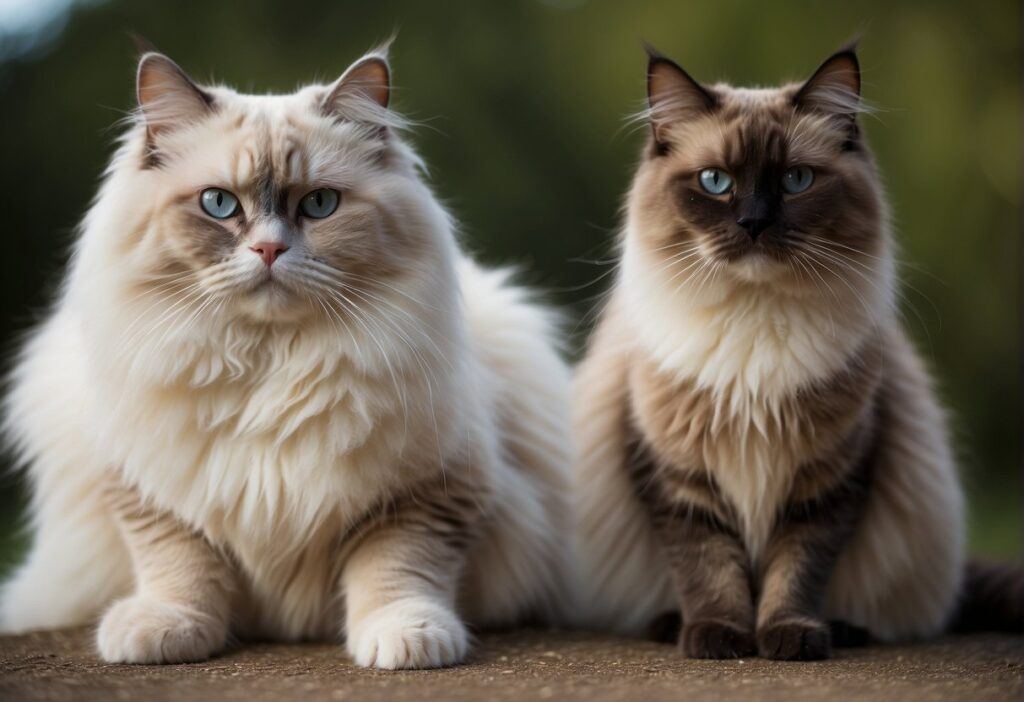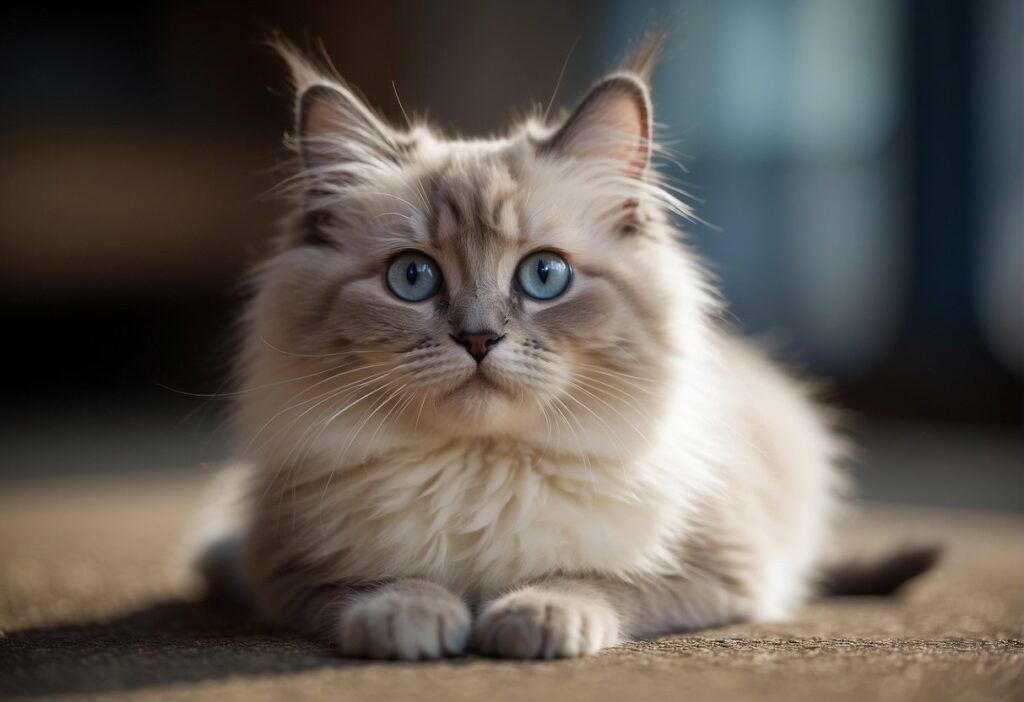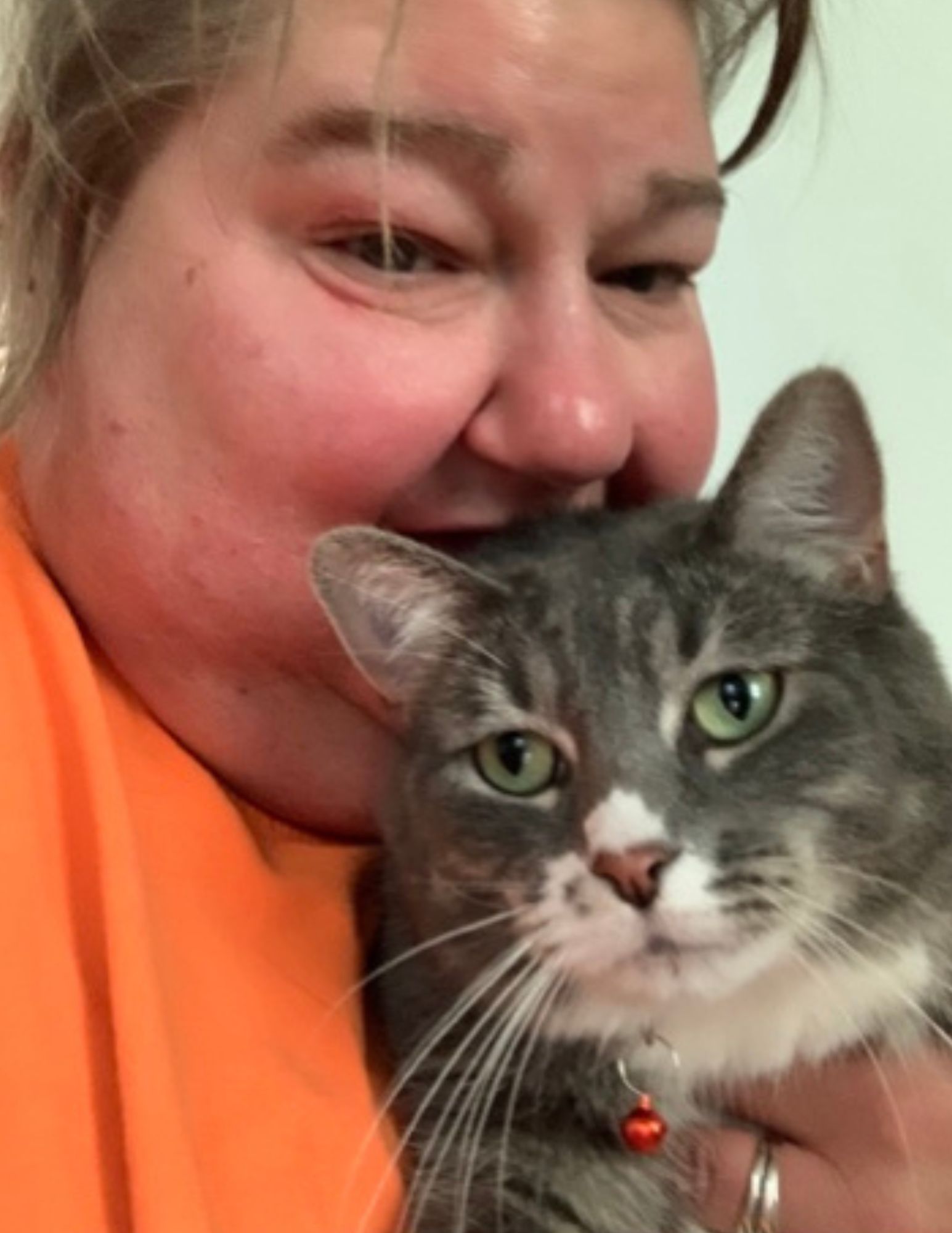Ragdoll cats are a breed distinguished by their large size and placid temperament.
This article, Ragdoll Size vs Normal Cat, provides a detailed look at how the Ragdoll stands out from the typical house cat, focusing on its unique breed characteristics.
We chart the Ragdoll’s growth from a cuddly kitten to a graceful adult with vivid blue eyes and a lush coat.
You’ll learn about their physical features, developmental stages, health and dietary needs, and the behavioral traits that make them so lovable.
We also cover their grooming essentials and the specific accommodations they need due to their considerable size.
Wrapping up with a discussion on breed standards that preserve their esteemed status, this piece is a concise guide to understanding the Ragdoll, the gentle giant of the cat world.
Ragdoll Cat Size Comparison

When comparing the Ragdoll cat to the average domestic cat, it is evident that Ragdolls are among the larger breeds.
A typical Ragdoll has a substantial build with a hefty bone structure, which contributes to their larger size.
Size Metrics:
- Full-grown Male Ragdolls:
- Weight: 12-20 pounds
- Length (including tail): up to 40 inches
- Full-grown Female Ragdolls:
- Weight: 8-15 pounds
- Length (including tail): slightly less than males
Average Domestic Cats: In contrast, average domestic cats weigh between 7-10 pounds, with a length of around 18 inches from nose to tail base.
Ragdolls are often compared to Maine Coons, which are one of the largest domesticated cat breeds.
Both breeds are iconic for their size and are known as gentle giants within the feline kingdom.
However, the Maine Coon can sometimes outsize the Ragdoll, with some specimens weighing well over 20 pounds.
As a popular cat breed notable for their docile nature and large size, Ragdolls fall in the category of larger domestic breeds of cats.
While they are not the largest, they are certainly a larger cat breed than the average domestic feline.
The Ragdoll’s size is both an attribute of the breed’s genetics and its highly regarded status among cat enthusiasts.
Owners of Ragdolls often seek out this breed not just for their temperament but also for their impressive and majestic size.
Female Ragdolls are typically smaller than their male counterparts, but they still maintain a considerable size when compared to the average cat.
Physical Characteristics of Ragdolls

Ragdolls are distinguished by their striking blue eyes, recognized as a hallmark trait of the breed.
These captivating eyes are set within a large, well-balanced, and proportionate head, giving Ragdolls a serene and pleasant appearance.
Their long fur is silky to the touch, often described as rabbit-like in its softness, contributing to their reputation as beautiful cats with plush, soft coats.
The body of a Ragdoll is substantial and muscular, with a broad chest conveying a powerful but gentle presence.
Their substantial bone structure is complemented by a medium to long, silky coat that demonstrates a slight fluff around the neck area, often referred to as a ruff, and a silky coat that drapes gracefully on their body.
Unlike domestic shorthairs, Ragdolls have a semi-longhair coat that requires regular grooming to maintain its luxurious feel and appearance.
They’re seen as affectionate cats and are often seen as great family pets due to their gentle temperament.
Ragdolls are considered beautiful breeds, with their coat colors ranging from seal, blue, chocolate, and lilac to various patterns, including colorpoint, mitted, and bicolor.
The combination of their physical attributes and endearing personalities makes Ragdolls a highly sought-after companion, solidifying their status as both beautiful and affectionate cats in the feline world.
Ragdoll Growth Patterns

Compared to average domestic cats, Ragdoll cats are distinguished by a prolonged growth period. They reach full maturity in size, coat color, and pattern by about 3 to 4 years of age.
Kitten to Adult Transition
Ragdoll kittens experience a significant growth spurt within their first eight months, transitioning smoothly from playful kittens to more substantial and muscular adults.
This breed continues to fill out in weight and structure well beyond the first year, unlike many domestic cats that may reach full size within a year.
Growth Rate and Full Size
The growth rate of Ragdoll cats is steady but slow, culminating in a substantial adult size that can weigh between 10 and 20 pounds for a healthy individual.
The timeframe for Ragdoll cats to reach their full size is typically broken down as follows:
- 3-6 months: Noticeable growth spurts occur.
- 6-12 months: Slower, progressive growth.
- 1-2 years of age: Continued growth, but at a reduced rate.
- Up to 4 years: Final stages of reaching full size.
Males often exhibit a significant difference in size compared to females, with males being heavier and larger overall.
Ragdolls are noteworthy for their gentle, laid-back temperament, which could be a factor in their attrition of apparent growth aggression.
They tend to grow harmoniously with their environment, fitting into households with a placid grace that matches their impressive stature.
Health and Nutrition for Ragdolls
Ragdoll cats require specific attention in terms of health and nutrition due to their unique breed characteristics.
Managing their diet and understanding common health challenges are key to ensuring a long, healthy life for these felines.
Common Health Issues
Ragdoll cats are prone to a few hereditary health issues. Hypertrophic cardiomyopathy (HCM) is the most common heart disease in Ragdolls, marked by thickened heart walls.
Regular veterinary screening is crucial for early detection and treatment. Polycystic kidney disease (PKD), a condition where cysts grow in the kidneys, also affects this breed.
Early symptoms can be subtle, so owners need to conduct routine health checks. Additionally, Ragdolls may develop bladder stones, which can cause urinary tract problems.
A balanced diet and plenty of water intake can help mitigate these risks.
Optimal Diet for Ragdolls
Ragdolls should consume high-quality cat food tailored to their specific needs to maintain a healthy weight.
The best diet plan for a Ragdoll includes wet and dry food, as wet food assists in hydration and provides dental benefits.
A balanced diet high in animal proteins and low in carbohydrates is generally recommended.
- Best Quality Proteins: Fish, poultry, and beef in wet food varieties.
- Balanced Dry Food: Specific to age and activity level, with essential vitamins and minerals.
- Consistent Meal Times: Helps prevent overfeeding and supports weight management.
Additional considerations for Ragdolls include controlling portions to prevent weight gain.
For cats needing weight loss, a veterinary-approved diet and exercise plan should be implemented to ensure a gradual and healthy reduction in weight.
Behavior and Temperament

Ragdoll cats distinguish themselves with a notably gentle and friendly temperament, often showing high affection towards their family members and adapting well to various household dynamics.
Social and Family Interaction
Ragdoll cats are known for their affectionate nature, making them ideal family pets.
They typically form strong bonds with their owners, including young children, and are considered to be gentle giants within the domestic cat world.
These cats are often called ideal lap cats because they seek human companionship and enjoy being held or cuddled.
- Affection: Responds well to positive reinforcement, showing affection to all family members.
- Adaptability: Capable of integrating into homes with young children, showcasing their relaxed nature.
Playfulness and Activity Levels
While Ragdolls are relaxed, they also exhibit a moderate activity level. They enjoy playtime and can interact with toys, although they are not as hyperactive as some other breeds.
- Gentleness: Playful but inherently gentle, making them suitable for homes where a placid pet is preferred.
- Engagement: Enjoys playing with family members, often exhibiting friendly personalities that cat owners admire.
Their combination of a laid-back attitude and occasional bursts of playful behavior contributes to the breed’s good looks and charm, reinforcing their reputation as affectionate companions suitable for a wide range of cat owners.
Related: Ragdoll vs Maine Coon
Care and Maintenance
Proper care for Ragdoll cats centers around meeting their specific grooming needs and ensuring their environment is enriched and engaging.
Grooming Needs
Ragdolls sport a luxurious semi-long coat that demands regular grooming to maintain its lush condition.
Owners should groom their Ragdoll cats with a steel comb at least twice weekly to prevent matting and reduce shedding.
Because they shed more than many other breeds, staying on top of this regimen is essential to keep their coat in tip-top shape.
Environmental Enrichment
Ragdolls are generally larger and may occupy more space, so their environmental needs differ slightly from those of a standard domestic cat.
Cat trees should be sturdy and sizable to accommodate the Ragdoll’s substantial size and allow them to exercise and exhibit natural behaviors.
The litter box also requires special consideration—it should be large enough to ensure the cat feels comfortable.
Providing multiple levels and scratching posts in the cat’s living environment helps to keep Ragdolls entertained for long periods and supports their well-being.
Related: Himalayan Cat vs Ragdoll
Ragdoll Breed Affiliations and Standards
Various cat fancier associations recognize the Ragdoll, which adheres to specific breed standards that ensure consistency and quality within the breed.
The Cat Fanciers’ Association (CFA), a significant governing body in the United States, is renowned for its rigorous standards, which include specifications for the Ragdoll’s large size, pointed color patterns, and distinctive blue eyes.
Another prominent organization, The International Ragdoll Cat Association (IRCA), is dedicated to the Ragdoll breed, championing its interests and upholding breed standards. It’s a noteworthy resource for both Ragdoll owners and breeders alike.
Ragdoll Fanciers Club International (RFCI) is an international club that brings together Ragdoll enthusiasts and breeders.
This club provides a wealth of information about the Ragdoll breed and a list of reputable breeders who commit to quality and ethical breeding practices.
Speaking of breeders, Ann Baker, the original breeder of the Ragdoll, played a crucial role in the breed’s development.
She laid the foundation for the breed standard still in use today. Her breeding practices resulted in the creation of the well-known Ragdoll sire, Daddy Warbucks, who is at the genetic heart of the breed.
Prospective Ragdoll owners are encouraged to engage with reputable breeders to ensure the breed’s integrity.
These breeders adhere to the standards set by the aforementioned associations and often register their cats and kittens to validate their lineage and health.
| Association | Function | Relevance to Ragdoll Breed |
|---|---|---|
| Cat Fanciers’ Association (CFA) | Sets and maintains breed standards | Recognizes and upholds standards for Ragdolls |
| International Ragdoll Cat Association (TIRCA) | Advocates for the breed | Focuses specifically on Ragdoll breed |
| Ragdoll Fanciers Club International (RFCI) | Supports Ragdoll enthusiasts and ethical breeding | Provides breeder resources and standards |
These affiliations play a critical role in preserving the breed’s unique characteristics and promoting the health, temperament, and beauty of Ragdolls.

Meet Ann Haasnoot, the passionate founder of CatFurLife.com. A lifelong cat lover from Wisconsin, Ann combines her extensive feline behavior and care knowledge with her love for writing. On her website, she shares invaluable insights about cat breeds, care tips, and her experiences with her beloved furbaby, aiming to deepen the bond between cats and their human companions.

